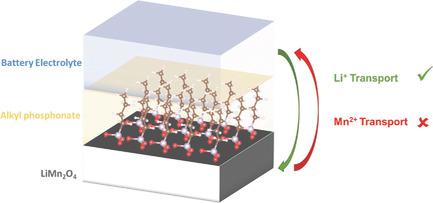当前位置:
X-MOL 学术
›
Adv. Mater. Interfaces
›
论文详情
Our official English website, www.x-mol.net, welcomes your feedback! (Note: you will need to create a separate account there.)
Controlling Interfacial Properties of Lithium‐Ion Battery Cathodes with Alkylphosphonate Self‐Assembled Monolayers
Advanced Materials Interfaces ( IF 5.4 ) Pub Date : 2018-03-07 , DOI: 10.1002/admi.201701292 Bruno G. Nicolau 1 , Aaron Petronico 1 , Kendra Letchworth-Weaver 2 , Yasaman Ghadar 3 , Richard T. Haasch 4 , Julio A. N. T. Soares 4 , Ryan T. Rooney 1 , Maria K. Y. Chan 2 , Andrew A. Gewirth 1 , Ralph G. Nuzzo 1
Advanced Materials Interfaces ( IF 5.4 ) Pub Date : 2018-03-07 , DOI: 10.1002/admi.201701292 Bruno G. Nicolau 1 , Aaron Petronico 1 , Kendra Letchworth-Weaver 2 , Yasaman Ghadar 3 , Richard T. Haasch 4 , Julio A. N. T. Soares 4 , Ryan T. Rooney 1 , Maria K. Y. Chan 2 , Andrew A. Gewirth 1 , Ralph G. Nuzzo 1
Affiliation

|
In this work, the preparation and characterization of modified LiMn2O4 (LMO) cathodes utilizing chemisorbed alkylphosphonic acids to chemically modify their surfaces are reported. Electrochemical methods to study ionic and molecular mobility through the alkylphosphonate self‐assembled monolayers (SAMs) for different alkyl chain compositions, in order to better understand their impact on the lithium‐ion electrochemistry, are utilized. Electrochemical trends for different chains correlate to trends observed in contact angle measurements and solvation energies obtained from computational methods, indicating that attributes of the microscopic wettability of these interfaces with the battery electrolyte have an important impact on ionic mobility. The effects of surface modification on Mn dissolution are also reported. The alkylphosphonate layer provides an important mode of chemical stabilization to the LMO, suppressing Mn dissolution by 90% during extended immersion in electrolytes. A more modest reduction in dissolution is found upon galvanostatic cycling, in comparison to pristine LMO cathodes. Taken together, the data suggest that alkylphosphonates provide a versatile means for the surface modification of lithium‐ion battery cathode materials allowing the design of specific interfaces through modification of organic chain functionalities.
中文翻译:

用烷基膦酸烷基酯自组装单层膜控制锂离子电池阴极的界面性质
在这项工作中,改性LiMn 2 O 4的制备和表征报道了利用化学吸附的烷基膦酸化学修饰其表面的(LMO)阴极。为了更好地了解它们对锂离子电化学的影响,采用了电化学方法研究通过烷基膦酸酯自组装单分子膜(SAMs)的离子和分子迁移率,以了解不同的烷基链组成。不同链的电化学趋势与在接触角测量和从计算方法获得的溶剂化能量中观察到的趋势相关,表明这些界面与电池电解质的微观润湿性的属性对离子迁移率具有重要影响。还报道了表面改性对Mn溶解的影响。烷基膦酸酯层为LMO提供了一种重要的化学稳定方式,在长时间浸入电解液中时,可将Mn溶解抑制90%。与原始的LMO阴极相比,在恒电流循环中发现溶解的降低程度较小。数据合计表明,烷基膦酸酯为锂离子电池正极材料的表面改性提供了一种通用的方法,从而可以通过有机链官能度的修饰来设计特定的界面。
更新日期:2018-03-07
中文翻译:

用烷基膦酸烷基酯自组装单层膜控制锂离子电池阴极的界面性质
在这项工作中,改性LiMn 2 O 4的制备和表征报道了利用化学吸附的烷基膦酸化学修饰其表面的(LMO)阴极。为了更好地了解它们对锂离子电化学的影响,采用了电化学方法研究通过烷基膦酸酯自组装单分子膜(SAMs)的离子和分子迁移率,以了解不同的烷基链组成。不同链的电化学趋势与在接触角测量和从计算方法获得的溶剂化能量中观察到的趋势相关,表明这些界面与电池电解质的微观润湿性的属性对离子迁移率具有重要影响。还报道了表面改性对Mn溶解的影响。烷基膦酸酯层为LMO提供了一种重要的化学稳定方式,在长时间浸入电解液中时,可将Mn溶解抑制90%。与原始的LMO阴极相比,在恒电流循环中发现溶解的降低程度较小。数据合计表明,烷基膦酸酯为锂离子电池正极材料的表面改性提供了一种通用的方法,从而可以通过有机链官能度的修饰来设计特定的界面。



























 京公网安备 11010802027423号
京公网安备 11010802027423号